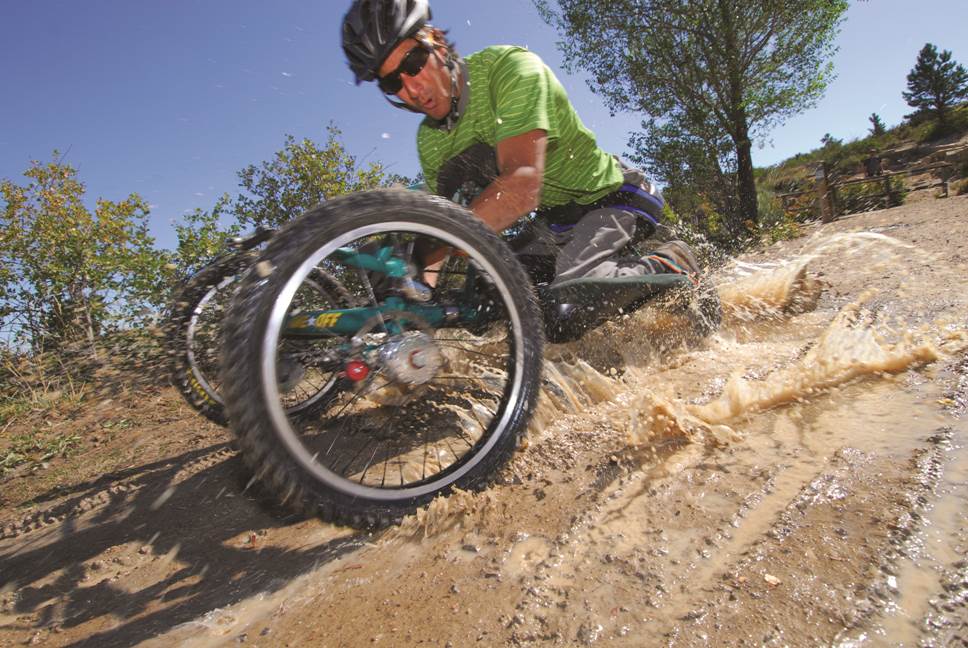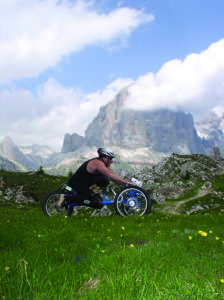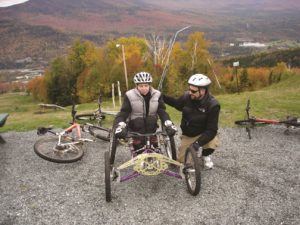
Mountain Biking
It’s All About the Rush!
Downhill is for those who want the rush. It’s high-speed and exhilarating.
– Sandy Olney
Mountain Biking 101
Rollin’ Down the Mountain
If you like nurturing your independence, appreciate the outdoors and enjoy an adrenalin rush, then downhill mountain biking may be the sport for you.
Downhill mountain biking is exactly what the name implies. You get to the top of a mountain or ski hill, transfer to a specially constructed bike with four wheels, and proceed to careen down to the bottom.
Although not necessarily for the faint of heart or those who prefer more tranquil ways to communicate with nature, mountain biking has a special niche for extreme sport enthusiasts and can be enjoyed by almost every ability.
“If you are able to wheel your own chair and are cognitively aware, you can mountain bike,” said Sandy Olney, a former program director for an adaptive sports organization in New Hampshire.
The bikes utilized for downhill mountain biking are specialized bikes known as 4-cross mountain bikes.
“The sport tends to get a younger crowd,” Olney notes. “When someone is interested in biking, we make an appointment and talk about the bike, how it works, what the ride is like. Then, we fit the user into the bike so it is comfortable and snug. And then, we show how the brakes work and the importance of keeping speed under control as you learn.”
Downhill mountain bikers get to their point of descent by using a ski lift or a four-wheel tow. At some locations, bikers use the ski lift to get to the top of the mountain; their bikes strapped to the chair preceding them. Once at the top, the lift operators disembark the bike and set it so the biker can directly transfer to it from the lift. Then, it’s just a matter of cruising downhill, Olney said.
“Downhill is for those who want the rush,” Olney said. “It’s high-speed and exhilarating.”

“Mountain biking is just like alpine skiing, with different levels of trails. You can have a nice downhill ride or go as fast as you want to go,” said Geoff Krill, a paraplegic and former professional downhill biker. “It’s open to lots of disabilities from amputees to quads. It’s a gravity sport so you don’t have to be in the best cardio shape. And it’s great for people with balance issues. Quads can mountain bike when adjustments are made to flip the brakes backward towards the driver. Quads can’t grab, but they can push. It’s also possible to tether mountain bikes together so a skilled biker can pilot another downhill.
“I never met a person who didn’t have a great time biking,” Krill said. “You can move through the forest like a deer. It’s a raw feeling; you don’t get that often in a chair.”
Krill advises first timers to get used to the bike by using the trails around the base of the mountain and learn how the bike reacts to different types of terrain. “Mountain biking is basically a way to hike down the mountain,” he said. “You can fly down the mountain or you can go slower.”
Krill began mountain biking in 1996, a year after he became disabled in a snowmobiling accident. “I was looking for a way to get back into the woods,” he said. “Once I got into it, I began racing.” He was a member of Team Phoenix, a group of off-road wheelchair racers who competed nationally and internationally.
The Adaptive Sports Center (ASC), Crested Butte, CO also has a mountain biking program with three downhill bikes.
“We decide with the biker what the best option is and what is the best fit,” said Chris Read, CTRS, program director for ASC of newcomers to the sport. “We go over the mechanics of the bike with them with braking the most important element. We try to customize the day for the participant. People’s comfort level varies and it is physically demanding. But people drawn to it have an adventurous spirit.”
Crested Butte also hosts an annual Off-Road Handcycling World Championship. The event last three days and usually takes places in late August or early September. To learn more about this event, ASC Crested Butte’s website.
An Alternative: Cross Country Mountain Biking
If you are not quite ready to go zooming down a mountain or you would just prefer a more scenic, slower bike ride, cross country mountain biking may what you are looking for. In this type of mountain biking, riders use a variety of off-road hancycles to explore trails, mountain bases, and technical singletracks. The terrain involved in cross country mountain biking is less extreme than in downhill, but the rider usually experiences a variety of twists and turns, hills, and occasional small jumps or rock drops.
Find a Program Near You
Ready to give this exhilarating sport a try? Check out these Move United network organizations that offer mountain biking.
Not a program near you? There are several other adaptive sport organizations throughout the country that offer mountain biking. Also, make sure to check out your local parks and recreation department for similar programs, as well as you local bike shops to find out about mountain biking or off-road cycling groups in your community!
Equipment and Adaptations
Because the elements of downhill differ from those of cross country, it is not surprising that the equipment needed for each class is different as well.
Downhill Equipment
4-Cross Downhill Bikes: These bikes are four-wheeled, full-suspension, gravity-driven cycles that use traditional mountain bike handlebars and hydraulic disc brakes. They have bigger tires than road cycles, which help absorb the bumps encountered on unpaved terrain. These bikes put riders into a position similar to sit-ski, with a “bucket” to sit in and a tray for the feet to rest on. The rider sits in an athletic position, with flex in both elbows while grasping both grips of the handlebar, and with a comfortable reach even when turning completely in either direction. This style of bike can be used by most individuals with good upper body and arm/hand strength.
4-Cross bikes are highly adaptable and can accommodate a very wide range of participants. Common adaptations include reversing brake levers to allow individuals with less grip strength to use their body weight to both steer and activate the brakes. Brake levers can also be repositioned in creative ways to accommodate impairments such as hemiplegia or amputations.
Krill owns four downhill mountain bikes, which he loans to NE Disabled Sports. “The problem is there are not a lot of manufacturers who make mountain bikes,” he said. “Many of the mountain bikes around are either older models or customized.”
Some of the manufactures who make downhill 4-cross bike include Active Force Foundation’s Skyline Quadcycle, Grove Inovations’ DH Mountain, and Tessier Equipment.
Apparel: Mountain bikers need to be prepared for the bumps, jars, and possible rollovers by equipping themselves with helmets, gloves, elbow pads, and body armor, sometimes called gladiator suits.
Cross Country Equipment
A variety of off-road handcycle styles are available for cross country mountain biking.
Delta Style: These off-road handcycles include models such as the Lasher All-Terrain Handcycle, or Varna Liberator Big Wheels Handcycle. These models are similar to their on-road counterparts in regard to design, positioning, and adjustments, but they utilize the larger tires and other components of mountain bikes, such as disc brakes and suspension. As they are front-wheel drive, this style of off-road handcycle often experiences issues with lack of traction while climbing steeper grades. A steering mechanism controlled solely by the crank-arms also results in less responsiveness while negotiating technical terrain. This design can be ideal for long-distance rides or rides that may encounter a variety of terrain (paved to dirt road to mild single-track).
Recumbent Upright: This style of off-road handcycles include models such as the Nuke (by ReActive Adaptations) or the Outrider Horizon. Like downhill bikes, these cycles have large tires. These handcycles also borrow advantages of comfortable positioning from the delta style cycles, combined with off-road design features of prone models such as rear-wheel drive and mountain-drives. These handcycles can serve a very wide range of participants and can be adapted to accommodate various impairments.
Unlike the delta style, the recumbent upright handcycle separates the crank arms from the steering arms and brake levers. The crank arms can be used to steer while pedaling, but the rider must transition from the cranks to the steering arms for more technical steering and to use the brakes. This positioning allows for greater control on technical descents, but the added complexity can be challenging for individuals with upper extremity impairments.
Standard adjustments for recumbent upright off-road handcycles include seat and back-rest angle as well as foot tray length. A rider should be positioned so that the crank arms comfortably clear the chest and stomach when closest to the rider, but keep a slight flex in the arms at the furthest point. Foot trays should allow for the rider’s legs to rest comfortably with the soles of their shoes just touching the end of the tray.
These off-road handcycles can be adapted in numerous ways, such as repositioning brake levers and shifters to accommodate for impairments to grip strength, arm/hand amputations, or other impairments. The adaptive grips and pedals described above can also be utilized on these types of handcycles. When adapting pedals/grips, ensure that the rider can use the braking system properly. Some custom pedals/grips incorporate a braking system into one of the crank pedals.
Tadpole Prone: These off-road handcycles such as the ReActive Adaptations Bomber and the One-Off Flyer put the rider in a kneeling position; these bikes are designed for individuals with good core strength. This more aggressive position enables traveling over technical terrain while either pedaling or rolling downhill. Similar to the upright handcycles, the rider adopts a different position for pedaling than for rolling downhill. While pedaling, riders lay their chest on the steering platform, still allowing minor adjustments in direction while propelling themselves forward. While rolling downhill, riders push up and hold onto the handlebars to allow for more precision in steering as well as access to the brake levers.
Like downhill bikes, they have large tires, but they are rear-wheel driven and have gears for a variety of uphill and downhill riding. They allow bikers to travel both paved road and rough terrain.
“They are versatile and they can go downhill quite well,” said Read.
“One-offs are designed for people with mid-level disabilities,” he said. “They need to use chest and trunk muscles to steer while pedaling.”
Standard adjustments for these handcycles include: raising or lowering the steering platform; changing the angle of the steering platform; and moving the seat tray fore and aft. The height of the steering platform should be adjusted to enable the rider to keep a slight bend in the elbow when the pedal is at its lowest point. The seat should be positioned and steering platform angled to allow the center of a rider’s chest to rest on the platform while pedaling.
There are limited adaptations available for these handcycles. Also, manufacturers often make custom builds that can accommodate various needs, such as for a rider with a leg amputation who needs a different position than the stock knee trays can provide.
Apparel: Since cross country does not have as many bumps or as high a chance of rollovers as downhill, riders do not need gladiator suits. However, it is crucial that they wear helmets, gloves, and occasionally gloves depending on the terrain while cycling.
Adaptive Cycling Equipment Suppliers
An Inspiring Feat
Crank it Up! Challenging the White Rim
 The documentary, “Crank it Up! Challenging the White Rim,” features three paraplegics, hand-peddling specialized adapted mountain bikes, the One-Off, on one of the most rugged and forbidding mountain bike trails in the world, the White Rim Trail in Canyonlands National Park, Utah. Although sharing a love of adventure and the outdoors, nothing but their commitment and determination to the ride was certain. Warren Miller’s cinema photographer Tom Day documented this six-day, 106-mile epic adventure. The film highlights the lives and events of each athlete; Steve Ackerman, who rode a handcycle around the world covering over 14,500 miles, Bob Vogel, former professional aerial skier and outdoor enthusiast, and Mark Wellman, first paraplegic to ascend El Capitan and Half Dome and to sit ski across the Sierra Nevada.
The documentary, “Crank it Up! Challenging the White Rim,” features three paraplegics, hand-peddling specialized adapted mountain bikes, the One-Off, on one of the most rugged and forbidding mountain bike trails in the world, the White Rim Trail in Canyonlands National Park, Utah. Although sharing a love of adventure and the outdoors, nothing but their commitment and determination to the ride was certain. Warren Miller’s cinema photographer Tom Day documented this six-day, 106-mile epic adventure. The film highlights the lives and events of each athlete; Steve Ackerman, who rode a handcycle around the world covering over 14,500 miles, Bob Vogel, former professional aerial skier and outdoor enthusiast, and Mark Wellman, first paraplegic to ascend El Capitan and Half Dome and to sit ski across the Sierra Nevada.
To Learn More
Adaptive Cycling Instructor’s Manual
The UNPavement trail blog

